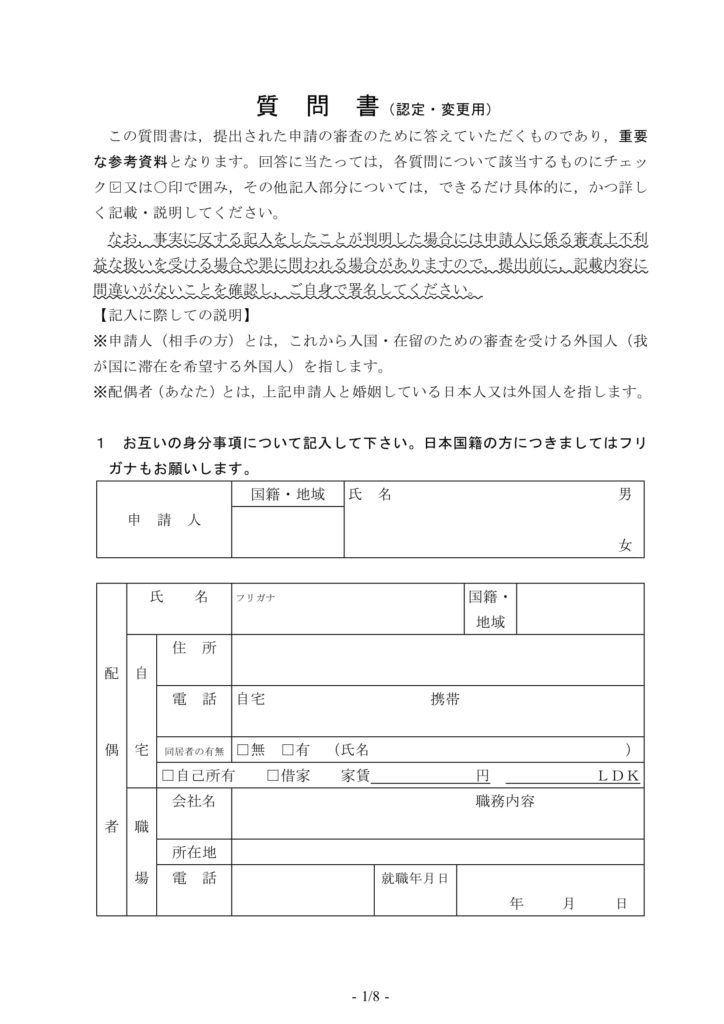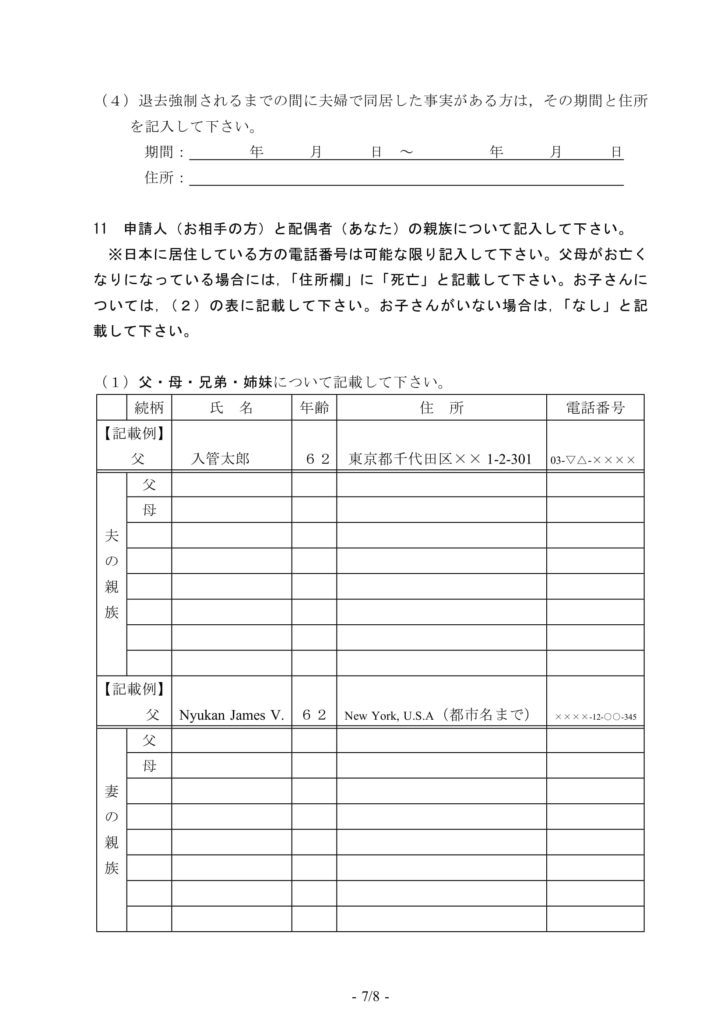Writing a “Questionnaire” for Spouse Visa Applications – “Spouse or Child of Japanese National,” “Spouse or Child of Permanent Resident,” “Long-Term Resident”

What is the Purpose of a “Questionnaire"?
First, take a look at the “Questionnaire". You can download it here. It is available in multiple languages including English, Chinese, Spanish, Portuguese, Thai, Korean, Tagalog, Vietnamese, and Indonesian.
The “Questionnaire" is required when applying for a change of residence status or a certificate of eligibility for certain visas such as “Spouse or Child of Japanese National", “Spouse or Child of Permanent Resident", and some “Long-Term Resident" visas.
The main purpose of the “Questionnaire" is to detect sham marriages.
Immigration authorities have created the “Questionnaire" based on past experiences to identify characteristics of sham marriages.
Conversely, if you understand its purpose clearly, you can provide answers that make it easier to pass the screening (this is not advice for those considering sham marriages).
How to Write a “Questionnaire" by Understanding Immigration’s Intentions
“Questionnaire": Page 1

The “Questionnaire" should be filled out by the spouse who married the foreign applicant. For example, a Japanese person for a “Spouse or Child of Japanese National" visa, or a permanent resident for a “Spouse or Child of Permanent Resident" visa.
On the first page, you write about the spouse. Although it may seem like administrative details, some questions have significant meaning.
The question about whether your home is “self-owned" or “rented" is meaningful. Owning a home indicates a certain level of wealth, which can be favorable for the application. Especially for older Japanese individuals, having significant assets is advantageous.
However, do not lie. If you own a home, you can enhance your application by providing a copy of the property registry.
The question about “LDK" (Living, Dining, Kitchen) is also important. For example, if you live in a one-room apartment, it could raise doubts about your marriage. If you live in a one-room apartment, consider moving to a larger place beforehand.
Regarding the workplace question, providing detailed company information and your employment start date can show stability, which is important as long-term employees at reputable companies are less likely to engage in sham marriages. Submitting employment certificates, company registration, brochures, and website copies can be beneficial.
“Questionnaire": Page 2

The question about when and where you first met should be answered as specifically as possible, including company names or shop names. Vague answers can sound suspicious.
Describe the process from your first meeting to getting married in as much detail as possible, including specific dates and locations. Try to include topics like:
- Your first date
- Trips taken together
- The day you started dating
- The day you proposed
- Meeting each other’s parents or family (including video chats)
- Visits from foreign parents to Japan
- Visits from Japanese parents to the foreign country
- Celebrations with family or friends
- Reasons for choosing the wedding date
- Details about the witnesses and when you asked them
You can use additional sheets of paper if you need more space. Detailed, specific answers are better.
In addition to the timeline, use this space to highlight anything that supports your case, such as having a Japanese-style wedding, owning a large house, or having a long-term employment history at a reputable company.
“Questionnaire": Page 3

The first half of page 3 asks about the introducer. There are two types of introducers considered here.
One is an individual introducer. These people engage in business by receiving fees from foreign nationals wanting sham marriages and finding Japanese spouses for them. For example, I was once approached by an elderly Chinese woman in a park who asked if I had any friends interested in marriage.
There is no problem if a friend or company colleague introduced you. In such cases, provide detailed information about the introducer to clarify that it was not an introduction by a suspicious person.
The other type is marriage agencies or dating sites. The issue is not with meeting through such services, but with those involved in sham marriages.
These organizations are blacklisted by immigration, so introductions through such sources are disadvantageous. However, trustworthy marriage agencies and major dating sites are not a problem. If you met through these, explain clearly which agency or site introduced you.
The worst approach is to vaguely state that the introducer is an “old acquaintance". If you claim to be old acquaintances, provide specific details such as attending the same high school (name the school) or working at the same previous job (name the company), and provide proof if possible.
The latter part of page 3 and the first part of page 4 ask about the language used for communication between the spouses.
If you marry someone from the same country, there are no issues. However, if your native languages differ, explain how you communicate in as much detail as possible.
If the foreign spouse has passed a Japanese language test or the Japanese spouse has high scores on English tests like TOEIC, include those certificates or scores as additional proof.
Even if your communication is basic, it’s acceptable. Mention if you use written communication or tools like Google Translate. Honesty is key; do not attempt to deceive.
“Questionnaire": Page 4

The latter half of page 4 asks about witnesses for the marriage registration. It is preferable to have Japanese witnesses, as they are less likely to assist in sham marriages.
Many people do not keep copies of their marriage registration, but if possible, keep a copy and attach it to your application.
“Questionnaire": Page 5

On the fifth page, section 5 asks about the wedding ceremony. Typically, sham marriages do not involve wedding ceremonies, so this question is significant. If you had a wedding, definitely mention it and submit photos and receipts.
Do not lie about having a wedding if you did not, as you may be asked to provide evidence later.
Section 6 addresses marriage history. For foreign spouses, this question is included because some individuals marry repeatedly to secure a visa to live in Japan.
On the other hand, some Japanese individuals engage in sham marriages as a business, repeatedly marrying foreign nationals. This question helps identify such individuals. Frequent marriages to foreign nationals can be disadvantageous, but honesty is essential.
Sections 7 and 8 consider cases where the foreign spouse lives abroad. These questions aim to determine how frequently the couple, separated between Japan and overseas, has met during their relationship and marriage.
Of course, meeting frequently is advantageous, so try to visit each other’s home countries as much as possible. Especially, it’s beneficial if the marriage procedures are completed together in each country. Having records of being together on the marriage registration day is ideal.
“Questionnaire”: Page 6

Sections 9 and 10 on page 6 ask if the applicant (the foreign spouse) has ever received a departure order or deportation. Ideally, there should be no such history, but honesty is crucial here.
If a departure order was issued, the individual can re-enter Japan after one year, and in the case of deportation, after five years (for overstaying). Deceptive answers will almost certainly be detected.
Receiving a prison sentence of more than one year results in an indefinite ban on entry.
If there is a five-year or indefinite entry ban, and you want the person to enter Japan sooner, the procedure involves applying for special permission to land.
“Questionnaire”: Page 7

Section 11 on page 7 asks about the families of the couple. It instructs you to provide addresses and phone numbers. While immigration rarely calls family members during the visa application process, it’s not entirely out of the question. There’s an implied pressure of, “We will contact your family if necessary.”
Again, honesty is the best policy here.
“Questionnaire”: Page 8

The top of page 8 asks about the children of the couple. This includes children from previous marriages. If the foreign spouse has children living abroad, it’s best to explain your plans for them. If the children are young, it’s not unusual to apply for their certificate of eligibility for residence together. In fact, not doing so might seem unnatural and could complicate future applications.
Section 12 asks, “Who in your family is aware of your marriage?” Naturally, it’s advantageous if everyone knows about it.
If your parents passed away long ago and you were raised by relatives, it might be necessary to explain your relationship with them as well.
Don’t hesitate to highlight any points that can support your case.
Summary of the “Questionnaire”
The “Questionnaire” is a tool designed to detect sham marriages, but for applicants, it’s also a tool to demonstrate the authenticity of their marriage.
Therefore, highlight any advantageous points and provide as much evidence as possible.
With this approach, obtaining a visa for “Spouse or Child of Japanese National” or “Spouse or Child of Permanent Resident” isn’t as challenging as it might seem.












